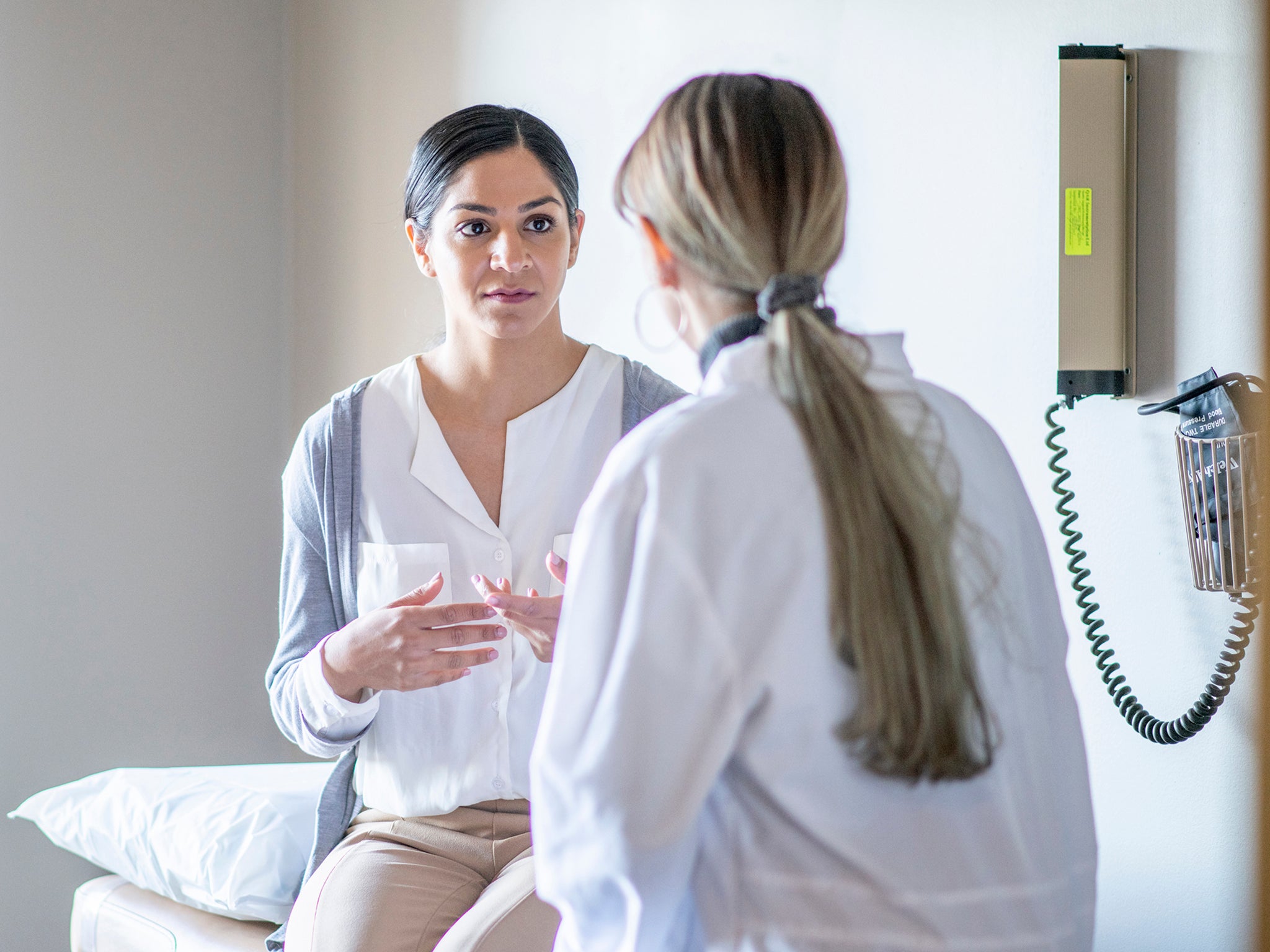‘I’ve been on the waitlist for over a year’: Britain is in the grip of a gynaecological crisis
According to NHS England data, more than 38,000 patients have been waiting more than a year for an appointment with a gynaecologist – even when their health is worsening. Elena Angelides meets some of the women and GPs on the front line

For three years, the pains in Rebecca*’s stomach, back and joints were becoming progressively worse. Physiotherapy didn’t ease it and tests confirmed it wasn’t arthritis, but detailed tracking revealed its link to her menstrual cycle. Soon, for between one and two weeks at a time – and before, during and after her period – the pain rendered her immobile and in need of a walking stick. She consulted her GP, who issued her prescription painkillers and medication for cramps, and also referred her to a gynaecologist. In December 2021, she received a hospital letter confirming her place on a gynaecology waitlist.
“What I didn’t realise is that I’d be on the waitlist for over a year,” she says. In that time, her physical and mental health – as well as her part-time studies for a PhD and her responsibilities as a mum of two teenagers – all suffered. “Having a fortnight out of action every month means I feel pressured to do my studying, household chores and social events when I’m functioning,” she says. “During immobile stints, my partner takes over the household responsibilities. I feel fortunate he can just about financially support us, [but I] can’t imagine what it’s like for single women with dependents who are unable to work.”
Rebecca is one of the 38,231 women left waiting for a gynaecology appointment for more than a year, according to NHS England data analysed by Labour in 2022. In December 2012, the average national waiting time to see a gynaecologist was 4.8 weeks. By December 2022, it had increased to 15.6 weeks, tripling in a decade.
Faye Farthing, head of communications at Endometriosis UK, says that cases like Rebecca’s aren’t unusual. “We regularly hear from [people] in chronic pain, without access to the right support due to long waiting times,” she says. “This can have a huge impact on all aspects of a person’s life, including their physical and mental health, as well as their career and relationships.”
After waiting seven months without an appointment, Rebecca invested in a £30 TENS machine, which uses electrical impulses to relieve pain. At 11 months, she went on a contraceptive pill to regulate her hormones, despite its previous negative impact on her mental health. “It was already so low, though, that I had to give it a go.”
Rebecca’s partner created a spreadsheet to track the days she’d likely be immobile, and they started to plan accordingly. But major life events were constantly affected. At her partner’s brother’s wedding, Rebecca used a walking stick that matched her dress – to find the glam in the situation. “It was a lovely day, but I couldn’t stand,” she says. “I sat in the church, trying not to cry. I didn’t make it to the reception. My partner helped me hobble to our hotel room, where I stayed for the night.”
It’s frustrating because of how the system works. Even though I’ve had a private consultation, I need an NHS consultation before they agree to a cystoscopy
Sofia* says her experiences as a general practitioner in south London validate Labour’s findings and what Rebecca has faced since her referral. “Gynaecology waiting times have definitely increased in the past 10 years, and it’s gotten worse since Covid,” she says. “The system is broken. The NHS workforce is demoralised and more burnt out than ever before. Consequently, patients are harmed.” She adds that a postcode lottery system regarding waiting times isn’t helping matters. “It’s area-dependent – some are up to a year, others six months. It’s difficult to see patients suffering and, as a GP, I feel out of my depth.” Sofia says that in instances of suspected gynaecological cancer, appointments can be sped up but that, largely, “the NHS doesn’t consider gynaecology urgent and necessary care”.
Rebecca tried to expedite her appointment three times but was told it wasn’t possible due to pressure on the service. Doctors have long suspected that she has endometriosis, a condition where tissue similar to the lining of the womb grows elsewhere, such as in the ovaries or fallopian tubes. The pathway to a diagnosis can vary, but it commonly involves a gynaecology appointment followed by a laparoscopy, a keyhole surgery that allows a surgeon to see inside the abdomen. But for more than a year she has been unable to have the condition confirmed. Finally, in December 2022, Rebecca was told she was able to see a gynaecologist. She’s now awaiting a scan and a potential laparoscopy to diagnose whether or not endometriosis has been the cause of her chronic pain. According to Endometriosis UK, and because the condition is so difficult to diagnose, it takes an average of 7.5 years between a woman’s first doctor’s appointment and a formal diagnosis. Farthing says that “urgent action” is needed to cut down that number.
Endometriosis isn’t the only women’s health issue that relies on a gynaecology appointment as a diagnostic stepping stone. The referral protocol for chronic urinary tract infections isn’t straightforward, and women can also wait years for a diagnosis. It leads many to seek private treatment.
Megan*, 24, was prescribed antibiotics by her GP in December 2021 after being diagnosed with a UTI. It returned for a third time within two months, however the latter two urine tests came back clear. Accepting a third round of antibiotics, she asked her GP for a referral. Oxford-based A&E doctor Danae Maragouthakis says women with chronic UTIs are typically referred to urogynaecology, a subspecialty of gynaecology within the NHS. However, depending on the suspected cause, the referral pathway could be to either gynaecology or urology.
“At the time, when the doctor warned it could be a 10-week wait, I thought that was bad,” Megan says. But in March 2022, after receiving a letter listing the nearest hospitals to her with gynaecology units, she logged into an online portal and discovered that her two closest options both had 52-week wait times. A third option was 55 miles away, and even then her wait would be 25 weeks.
Megan already suffered from anxiety, and her symptoms – a burning sensation during and after urination, along with extreme discomfort and pain in her sides and pelvis – were exacerbating it. Desperate to return to normality, Megan scraped together the money for a private urogynaecologist. She spent £780 in total (£200 for an initial appointment, £150 for a follow-up and £430 for an ultrasound) but hit a wall when she couldn’t afford a cystoscopy. That would unearth the cause of the UTI but also cost more than £1,000. “It’s frustrating because of how the system works,” she says. “Even though I’ve had a private consultation, I need an NHS consultation before they agree to a cystoscopy. So, despite spending £780, I’m back to square one.”

In September, she received a second hospital letter: the waiting time had extended to 72 weeks, and she could only join once it got down to 52 weeks. As of January 2023, she’s still waiting to join the list.
Many today are being forced to choose between their health and finances when confronted with long NHS waiting times. In 2015, four volunteers founded the Chronic Urinary Tract Infection Campaign. Co-founder Carolyn Andrew, who has experienced her own difficulties in getting a medical diagnosis, tells me that only one specialist NHS chronic UTI centre exists in the UK. It also doesn’t accept referrals from GPs, only secondary care specialists such as a gynaecologist or urologist. It means an appointment with either is required first, making the diagnostic process far longer.
This nebulous referral pathway is complicated by antiquated diagnostic testing and criteria. Urine tests and dipstick tests are based on outdated research. Like Megan, Andrew’s urine tests came back negative, and she was told she didn’t have a UTI. After paying for a private test, she was further told that the original UTI had become embedded in her bladder wall, and that she now had a long-term, chronic condition. “Although the NHS uses the term ‘long-term (chronic) UTI’ in their online information, the condition has no real definition,” she says. “The National Institute for Health and Care Excellence has no guidelines for treating long-term and chronic UTIs, and doctors are limited to ineffective treatments.”
Megan and Rebecca tell me that one of the hardest parts of their experience has been being left in a state of limbo. Sadly, they’re just two of thousands of people currently waiting to see a gynaecologist as their physical and mental health deteriorates.
“While the situation hasn’t got worse, it hasn’t gone away,” Megan tells me. “I can’t believe I’m a year in and still don’t know the cause.”
* Rebecca, Sofia and Megan’s names have been changed
Join our commenting forum
Join thought-provoking conversations, follow other Independent readers and see their replies
Comments


Bookmark popover
Removed from bookmarks